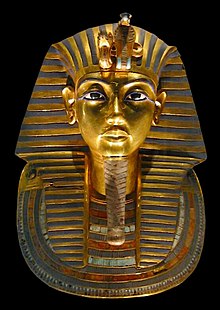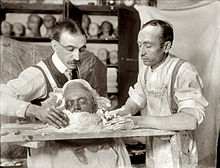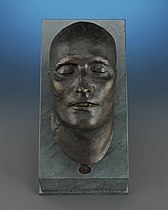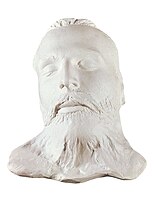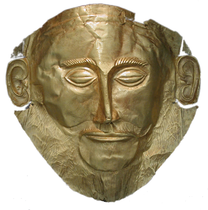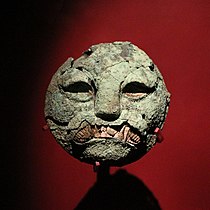Death mask
European death masks are mostly plaster of paris - or wax impressions of the face of a deceased. In non-European cultures (Egypt, China, Mesoamerica) the face of a high-ranking deceased (ruler or priest-king) was sometimes covered with a precious stone or metal mask ( gold , bronze ) in the course of the burial ceremony , with no or only no resemblance to the living person played a subordinate role. One would therefore have to distinguish between modern “portrait” or “memory masks”, which could also be reworked and thus idealized, but were never given to the grave, and antique “funeral masks”, which in some cases could also have realistic features.
Manufacture of a European portrait mask
In the past, a thin layer of plaster of paris was applied to the person's face and a thread was embedded in the fresh plaster of paris, running vertically over the forehead, nose, mouth and chin. Then another layer of plaster was added to form a solid cap. Before the mass solidified completely, the thread was pulled out at both ends at the same time. This created a seam to easily remove the larva from the face in two parts. The halves were then put back together and small chips in the negative were repaired. Then this was again filled with plaster of paris and the cap (the negative) carefully knocked down. This is why this procedure is called a so-called lost form . A piece shape was then created from the positive, which could be used to make further copies (an indication of a copy, as can be seen on some older mask copies: a coarse network of cast seams runs over the mask).
Nowadays, silicone mixtures or a special alginate are used for pouring, as they have proven to be more effective in depicting the smallest of skin details.
history
Many death masks were made of gold in antiquity and ancient Egypt , whereby the Egyptian masks are not death masks in the narrower sense, as they were freely designed and not worked on the face of the dead as described above. The death mask of Tutankhamun is one of the most famous Egyptian masks . Another well-known mask of a deceased is the gold mask of Agamemnon . The tradition of painted or sculpted portraits of the dead lasted for a long time: Polybius reported in the 2nd century BC. Of pompous funerals:
- “When you have now buried and completed the usual customs, place the picture of the deceased in the most visible room of your house in wooden chapels. It is an excellent, similar, three-dimensional and painterly elaborated portrait. They open these images and decorate them respectfully at public festivals, and when a respected family member dies, they bring them to the funeral procession, in which they put them on people who are as similar as possible to the person concerned in terms of size and other appearance. "( Historia universalis VI , Chapter 53)
Pliny the Elder mentions plaster casts of the faces of the deceased for the first time in the Historia naturalis XXXV as an invention of Lysistratos , a brother of Lysippus ; the impression was taken from the face with plaster of paris, then the plaster molds obtained were poured out with wax and reworked. Such masks were particularly popular during the Classical period , as they made it easier to remember deceased ancestors or other personalities. Such masks were therefore not intended as grave goods .
This tradition was lost in late antiquity and was only taken up again in the late Middle Ages or in the Renaissance. Bernardine of Siena († 1444) was one of the first to have a death mask removed from his face as a model for a terracotta portrait.
Unprocessed death masks can have a deterrent effect on the unprepared viewer due to the sight of the sunken face (such as the death mask of Frederick the Great ). That is why, during the Renaissance, many death masks were reworked so that they cannot give any unadulterated information about the actual appearance of the deceased. Mainly they were used in all times to make portraits or busts from the masks .
It was not until the 19th century that their intrinsic value and significance for art were recognized. For this reason, death masks or live masks (face masks) were removed from many important personalities. In today's funeral system, the production of death masks for the deceased is one of the areas of thanatopraxis .
The death mask of the painter Max Liebermann († 1935) is one of the most unusual impressions. At the widow's request, the sculptor Arno Breker had molded the entire head to the highest degree of perfection. A bronze cast belonged to the collection of the Prussian Cultural Heritage Foundation after 1945 . It is temporarily exhibited in the Jewish Museum Berlin . One copy is in the Arno Breker Museum.
Examples of death masks
- European death masks of modern times (portrait or commemorative masks)
Oliver Cromwell
(† 1658)Blaise Pascal († 1662)
Gustav III of Sweden († 1792)
Napoleon Bonaparte († 1821)
Maximilian I (Mexico) († 1867)
Adalbert Stifter
(† 1868)Egon Schiele († 1918)
- ancient European and non-European death masks (funeral masks)
so-called gold mask of Agamemnon from Mycenae
(16th century BC)Tutankhamun († 1323 BC)
Sipán (around 500 AD)
Mixtec death mask made of thin jade plates from Monte Alban (7th century)
Maya jade mask (8th century)
Mongolian funeral mask, Liao dynasty (10th century)
Others
For some people, a face cast was made while they were still alive (e.g. Abraham Lincoln ).
See also
literature
- Ernst Benkard : The Eternal Face. A collection of death masks. Frankfurter Verl.-Anst., Berlin 1927.
- Michael Hertl: death masks. What remains of life and death. Thorbecke, Stuttgart 2002, ISBN 3-7995-0099-5 .
- Urte Krass : Black Box cult of saints. The death mask as a double interface. In: Katharina Hoins, Thomas Kühn, Johannes Mücke (Eds.): Interfaces. The presence of the absent (= series of the Isa Lohmann-Siems Foundation. Vol. 7). Reimer, Berlin 2014, ISBN 978-3-496-02862-8 , pp. 150-171.
- Claudia Schmölders : The death mask. To the reliquary of physiognomy. In: Jan Assmann , Rolf Traubie (Ed.): Death, Beyond and Identity. Perspectives of a cultural-scientific thanatology. Alber, Freiburg / Munich 2002, ISBN 3-495-47931-7 , pp. 173-193.
- Caroline Welsh: On the cultural history of the death mask. In: Jonas Maatsch, Christoph Schmälzle (Ed.): Schiller's skull. Physiognomy of an Fixed Idea (= volume accompanying the exhibition "Schiller's Skull - Physiognomy of an Fixed Idea", Schiller Museum, Weimar, September 24, 2009 to January 31, 2010). Wallstein, Göttingen 2009, ISBN 978-3-8353-0575-5 , pp. 68-72.
Web links
- Virtual Museum of Death Mask (English)
- Laurence Hutton Collection of Life and Death Masks (English)
- Death masks in the archive of the Akademie der Künste, Berlin
- History and aspects of the death masks
- Death masks and stone masks from Mexico
Individual evidence
- ↑ s. on this: Elmar Worgull : Franz Schubert's face mask and its role model function in Moritz von Schwind's drawings . In: Elmar Worgull: Franz Schubert in image documents of his friends and contemporaries. Art-historical considerations on Schubert's iconography . Wernersche Verlagsgesellschaft, Worms 2018, ISBN 978-3-88462-388-6 . Pp. 55-79.
- ^ Photo of Liebermann's death mask by Arno Breker
